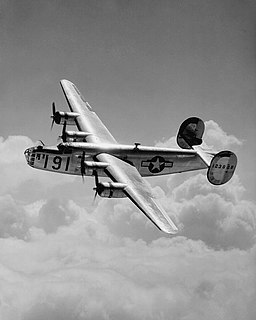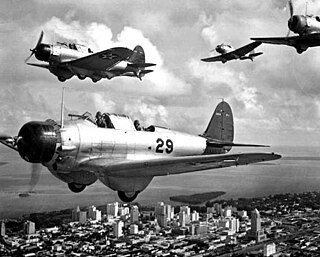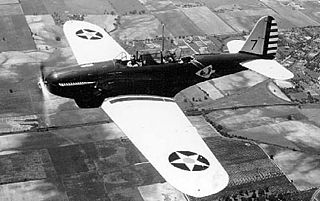
The Consolidated B-24 Liberator is an American heavy bomber, designed by Consolidated Aircraft of San Diego, California. It was known within the company as the Model 32, and some initial production aircraft were laid down as export models designated as various LB-30s, in the Land Bomber design category.

The Consolidated B-32 Dominator was an American heavy strategic bomber built for United States Army Air Forces during World War II, which had the distinction of being the last Allied aircraft to be engaged in combat during World War II. It was developed by Consolidated Aircraft in parallel with the Boeing B-29 Superfortress as a fallback design should the B-29 prove unsuccessful. The B-32 only reached units in the Pacific during mid-1945, and subsequently saw only limited combat operations against Japanese targets before the end of the war. Most of the extant orders of the B-32 were canceled shortly thereafter and only 118 B-32 airframes of all types were built.

The Consolidated TBY Sea Wolf was a United States Navy torpedo bomber of World War II. A competitor and contemporary to the Grumman TBF Avenger, the Sea Wolf was subject to substantial delays and never saw combat; only 180 of the type were built before cancellation after VJ Day.

The Blackburn B-24 Skua was a carrier-based low-wing, two-seater, single-radial engine aircraft operated by the British Fleet Air Arm which combined the functions of a dive bomber and fighter. It was designed in the mid-1930s and saw service in the early part of the Second World War. It took its name from the sea bird.

The Boeing XB-15 was a United States bomber aircraft designed in 1934 as a test for the United States Army Air Corps (USAAC) to see if it would be possible to build a heavy bomber with a 5,000 mi (8,000 km) range. For a year beginning in mid-1935 it was designated the XBLR-1. When it first flew in 1937, it was the most massive and voluminous airplane ever built in the US. It set a number of load-to-altitude records for land-based aircraft, including carrying a 31,205 lb (14,154 kg) payload to 8,200 ft (2,500 m) on 30 July 1939.

The Vought SB2U Vindicator is an American carrier-based dive bomber developed for the United States Navy in the 1930s, the first monoplane in this role. Vindicators still remained in service at the time of the Battle of Midway, but by 1943, all had been withdrawn to training units. It was known as the Chesapeake in Royal Navy service.

The Heinkel He 118 was a prototype German monoplane dive bomber design that lost out to the Junkers Ju 87 Stuka in the 1930s, and was never ordered by the Luftwaffe.

The Convair XB-46 was a single example of an experimental medium jet bomber which was developed in the mid-1940s but which never saw production or active duty. It competed with similar designs, the North American XB-45 and Martin XB-48, all of which saw little use after the successful development of the Boeing XB-47.

The Vought SBU-1 Corsair was a two-seat, all-metal biplane dive bomber built by Vought Aircraft Company of Dallas, Texas for the US Navy. Its design was based upon the F3U-1 two-seat fighter that was abandoned when the Navy decided not to obtain any more two-seat fighters.

The Boeing YB-9 was the first all-metal monoplane bomber aircraft designed for the United States Army Air Corps. The YB-9 was an enlarged alteration of Boeing's Model 200 Monomail commercial transport.

The Northrop BT was an American two-seat, single-engine monoplane dive bomber built by the Northrop Corporation for the United States Navy. At the time, Northrop was a subsidiary of the Douglas Aircraft Company. While unsuccessful in its own right, the BT was subsequently redesigned into the Douglas SBD Dauntless, which would form the backbone of the Navy's dive bomber force.

The Vultee V-11 and V-12 were American stressed-skin monocoque monoplane attack aircraft of the 1930s. Developed from the Vultee V-1 single-engined airliner, the V-11 and V-12 were purchased by several nations for their armed forces, including China, who used them in combat against Japanese forces in the Second Sino-Japanese War. The United States Army Air Corps purchased seven V-11s as the YA-19 in the years before World War II, testing them to gather data to compare against twin engine light attack aircraft.

The Hall XPTBH was a prototype American twin-engined seaplane, submitted to the United States Navy by the Hall Aluminum Aircraft Corporation in response to a 1934 specification for new bomber and scout aircraft. Constructed in an innovative fashion that made extensive use of aluminum, the XPTBH proved successful in flight testing, but failed to win favor with the U.S. Navy. No production contract was awarded, and the single aircraft built served in experimental duties before its destruction in a hurricane during 1938.

The Consolidated P-30 (PB-2) was a 1930s United States two-seat fighter aircraft. An attack version called the A-11 was also built, along with two Y1P-25 prototypes and YP-27, Y1P-28, and XP-33 proposals. The P-30 is significant for being the first fighter in United States Army Air Corps service to have retractable landing gear, an enclosed and heated cockpit for the pilot, and an exhaust-driven turbo-supercharger for altitude operation.

The Douglas T2D was an American twin-engined torpedo bomber contracted by the military, and required to be usable on wheels or floats, and operating from aircraft carriers. It was the first twin-engined aircraft to be operated from an aircraft carrier.

The Grumman XSBF, also known by the company designation G-14, was an American biplane scout bomber developed by Grumman Aircraft for the United States Navy during the 1930s. Derived from Grumman's successful "Fifi" fighter, the aircraft was developed at a time when the biplane was giving way to the monoplane. In competition against other aircraft it proved to possess inferior performance in its intended role, and did not enter production. The sole prototype went on to serve as a liaison aircraft, as well as being used in experiments by NACA, before being destroyed in a crash in 1939.

The Great Lakes BG was an American carrier-based dive bomber of the 1930s. Designed and built by the Great Lakes Aircraft Company of Cleveland, Ohio, 61 were used by the United States Navy and United States Marine Corps from 1934 to 1940.

The Northrop XFT was an American prototype fighter aircraft of the 1930s. A single engined low-winged monoplane, it was designed and built to meet a United States Navy order for an advanced carrier based fighter. It exhibited poor handling, and was rejected by the Navy, the single prototype being lost in a crash. A variant, the Northrop 3A, also was unsuccessful.

The Douglas XP3D was a prototype American patrol flying boat of the 1930s. A twin-engined high-winged monoplane, the P3D was produced by the Douglas Aircraft Company to equip the US Navy's Patrol squadrons, but despite meeting the Navy's requirements, the rival Consolidated PBY was preferred owing to a lower price.
The Arado Ar 81 was a German prototype dive bomber. Because the Reich Air Ministry decided to purchase the competing Junkers Ju 87, only three prototypes of the Ar 81 were completed.





















